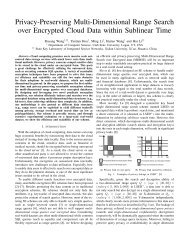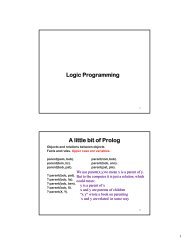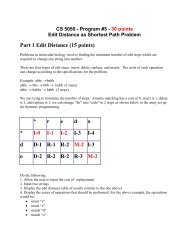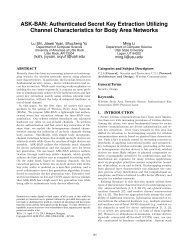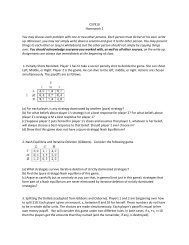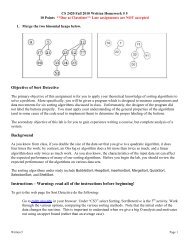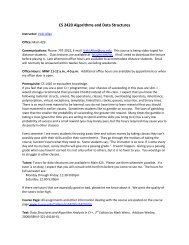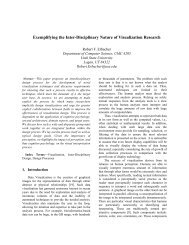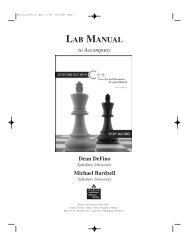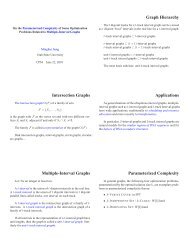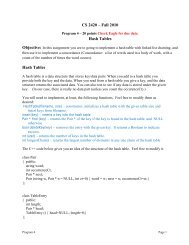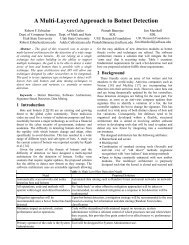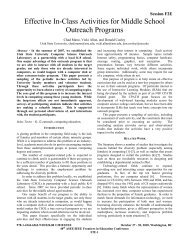CS 4700 - Exam #1 - 100 points Spring 2011 Multiple Choice (2 ...
CS 4700 - Exam #1 - 100 points Spring 2011 Multiple Choice (2 ...
CS 4700 - Exam #1 - 100 points Spring 2011 Multiple Choice (2 ...
You also want an ePaper? Increase the reach of your titles
YUMPU automatically turns print PDFs into web optimized ePapers that Google loves.
<strong>CS</strong> <strong>4700</strong> - <strong>Exam</strong> <strong>#1</strong> - <strong>100</strong> <strong>points</strong> <strong>Spring</strong> <strong>2011</strong><br />
Fill in the blanks (1 point each)<br />
1. _____syntactic sugar ____________________________ is a term coined for additions to<br />
the syntax of a computer language that do not affect its expressiveness but make it nicer for<br />
humans to use.<br />
2. _______abstraction ______________________ means complicated structures can be stated<br />
in simple ways by ignoring many of the details.<br />
3. In the pre-parsing phase termed_____lexical analysis __________________________ ,<br />
characters are grouped into logical chunks (keywords, constants, etc) . The actual strings<br />
that are matched are termed ______lexemes___________.<br />
4. A metalanguage is a language used to describe_____another language ___________.<br />
5. ____Generality____________________ refers to combining closely related constructs into a<br />
single more general one.<br />
6. _____Orthogonality___________ means features can be combined in any combination.<br />
7. When similar things look the same, and different things look different we term it _________<br />
Uniformity______________________<br />
8. With understatement independent, a user need only know about _____subset___ explicitly<br />
used to write the program.<br />
9. ____Preciseness________________________ means there exists a language definition that<br />
can answer programmers’ and implementers’ questions.<br />
10. A glue language used for connected software components is considered to be part of the<br />
_________scripting_________________ paradigm.<br />
<strong>Multiple</strong> <strong>Choice</strong> (2 <strong>points</strong> each) Circle the single best answer.<br />
1. When a language feature is independent of the context in which it is used, we term it<br />
a. portable<br />
b. **orthogonal<br />
c. readable<br />
d. unified<br />
2. Why do we care if a grammar is ambiguous?<br />
a. We don’t really. While ambiguity is interesting, it is not important.<br />
b. It takes longer to parse.<br />
c. **A different semantic meaning is associated with a different parse tree<br />
a. none of the above<br />
3. Lexical analysis is separated from syntax analysis because:<br />
a. **lexical analysis is less complex.<br />
b. optimizing the lexical analyzer provides more benefits than optimizing the syntax analyzer.<br />
c. lexical analysis has to perform input/output operations and, therefore, is platform dependent.<br />
d. all of the above.<br />
0
4. The C++ programming language is very popular because it is:<br />
a. backward compatible with C.<br />
b. object-oriented.<br />
c. widely available.<br />
d. **all of the above<br />
5. An alternate term for lexical analyzer is:<br />
a. **scanner<br />
b. parser<br />
c. pushdown automaton<br />
d. all of the above<br />
6. A concept of ________ means that a small number of primitive constructs can be combined in<br />
a small number of ways to build the control and data structures of the language.<br />
a. **simplicity<br />
b. parsimony<br />
c. relativity<br />
d. orthogonality<br />
7. The most common programming languages, dating back to the 1940s are called:<br />
a. functional.<br />
b. object-oriented.<br />
c. rule-based.<br />
d.** imperative.<br />
8. Which of the following represent a static semantic error in C++?<br />
a. **type mismatch<br />
b. missing semi-colon<br />
c. illegal character<br />
d. division by zero<br />
e. all of the above<br />
9. Which of the following represent a dynamic semantic error?<br />
a. type mismatch<br />
b. missing semi-colon<br />
c. illegal character<br />
d. **division by zero<br />
e. all of the above<br />
10. Ruby has the advantage that we can return multiple values by<br />
a. Using an asterisk before the variable name<br />
b. **Listing multiple values on the left hand side<br />
c. Returning a structure<br />
d. All of the above<br />
11. In Ruby, when a code block is passed to a method, the scope of the non-local variables in the<br />
block are<br />
a. **the scope from which the block was called<br />
b. the scope where the block is executed<br />
c. non-local variables cannot be used in a block<br />
1
Short Answer<br />
way.<br />
1. (7 <strong>points</strong>) Write a regular expression for strings of 0’s and 1’s in which the string 101<br />
never occurs as a substring (but all other combinations of 0 and 1 are allowed). For<br />
example, 0000, 1<strong>100</strong>1, and 1<strong>100</strong> are legal. <strong>100</strong>11011 is illegal.<br />
0*1*( 00+1*)*0*<br />
Some of you thought you could say something like [^101] – but the not doesn't work that<br />
2. (8 <strong>points</strong>) What does the following Ruby code do?<br />
def generate (length=16)<br />
chars = 'abcdefghjkmnpqrstuvwxyzABCDEFGHJKLMNOPQRSTUVWXYZ23456789'<br />
word = ' '<br />
length.downto(1) { |i| word
4. (10 <strong>points</strong>) Write the Ruby code to do the following: Given an array of string words, build<br />
an array of only those words in the array that are anagrams of the first word in the array.<br />
Recall, two words are anagrams if they contain exactly the same letters.<br />
myList = [posh hops are purchased at the food shop]<br />
newList = [posh, hops, shop]<br />
def match(a,b)<br />
aa = a.split('').sort<br />
bb = b.split('').sort<br />
aa==bb<br />
end<br />
mylist = ["posh", "hops", "are", "purchased", "at", "the", "food", "shop"]<br />
p mylist<br />
newlist = []<br />
first = mylist[0];<br />
mylist.each{|w|<br />
newlist
5. (10 <strong>points</strong>) in Ruby, define a method to count the number of times a vowel occurs in the given<br />
string.<br />
def vowel_count(myString)<br />
mystring = "Now is the time for all good men"<br />
p mystring.count('aeiou')<br />
4
6. (12 <strong>points</strong>) Consider the Ruby programming language as defined in this class. You are charged<br />
with making design changes to Ruby so that it can be used by professional developers to rapidly<br />
produce correct, efficient, and maintainable code. Identify four problems with Ruby that prevent<br />
it from attaining those goals. Explain each problem, explain how you would change Ruby, and<br />
justify your change. Be concrete. Choose problems and solutions to show off your knowledge. The<br />
aspects you change can occur at any level (e.g., lexical analysis, parsing, semantic analysis, runtime,<br />
language features, etc.).<br />
Possible problems include:<br />
1. dynamic type makes it hard to maintain<br />
2. inserting into middle of an array makes it less efficient<br />
3. All the special variables makes it hard to learn<br />
4. The multiple ways to do the same thing makes it hard to maintain<br />
How to fix them varies…<br />
5
7. (6 <strong>points</strong>) Algol family languages are typically compiled, while Lisp family languages, where<br />
many issues cannot be settled until run time, are typically interpreted. Is interpretation simply what<br />
one “has to do” when compilation is infeasible, or are there actually some advantages to interpreting<br />
a language, even when a compiler is available? Explain.<br />
Coding in an interpreted environment can be easier to develop with as the errors are shown<br />
immediately.<br />
8 . (8 <strong>points</strong>) Discuss the reasons why languages such as Fortran, Algol, and PL/I designed in 1950s<br />
and 1960s are less widely used than languages designed in the last 20 years.<br />
Actually, there are a lot of reasons. Algol didn't have standardized I/O. Pl/1 was too big. Fortran<br />
didn't have recursion or objects. The old languages don't take advantage of new machines or needs<br />
of new applications.<br />
6



